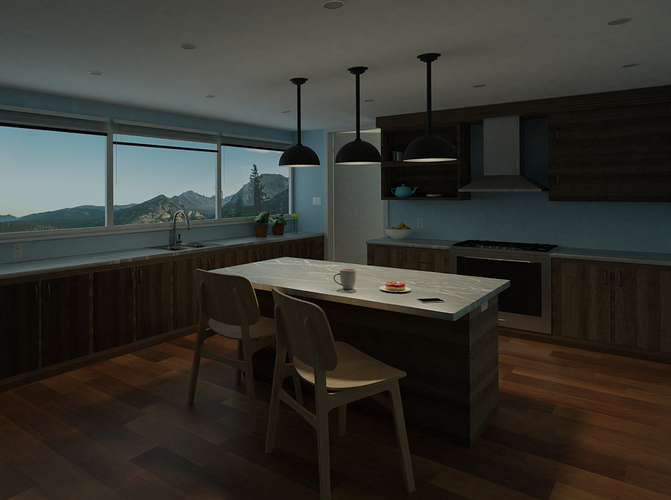Hi, thats a nice render! And welcome to the forum here. I like the overall idea but would change the following:
- Floor: texture is ok, maybe a bit dark and saturated, but I would scale the texture so that the planks look longer, not that wide.
- I would change the texture of the other wood like the cupboards. The pattern is so notable. Maybe look for something more subtle.
- More expose (multiply).
- There is a kinda haze, you can remove that with contrast, but that’s tricky I think because you have some (close to) black materials. So could be that you need to make the albedo values for black more plausible, but it’s a matter of experimenting. I cannot see it well.
- I think it’s interesting to check pivoted contrast for this render. I made a tutorial for that and if you are interested, you could look up :compositing and scene referred data.
- I would also make bevels there where you see sharp edges.
- Overal, the roughness of materials is high. That could be nice, but maybe you want to experiment to lower it.
- Sometimes I cheat a bit with lowering the specularity. It’s a bit to long to explain why I do that. (Real geometry is different in the real world than in Blender and therefore not everything turns out as calculated).
Thanks for the tips!
I think that the tonal range of the image needs a little boosting on the low end: the cabinets and the area in front of the chairs is, to my eyes, just a little bit too dark. I also question the scale of the sink … it seems too small. However, in general, I’d say, “yeah, you’ve got a really good start here.” You could even decide that it’s almost-finished and try another scene. 
The model is already done. I just posted it now so I could get some feedback. Maybe I will work on it more sometime. Thanks anyway!
I’ve assisted in quite a few real-world, first film and now digital, photo shoots, and one thing I’ve noticed is how photographers will place out-of-sight strobes in various places, often with very low power levels, strictly to “inject” small amounts of light into shadowed areas. The lights and their effects are not intended to be “noticed,” and you wouldn’t notice unless you knew to look for them.
In the magic world of CG, of course, we can now place such lights “in plain sight,” knowing that they cannot be seen.
Thanks for the tip!
